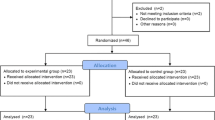Abstract
Purpose
The aim of this study was to evaluate the results of a conservative intervention in infants with plagiocephaly according to their specific clinical profile.
Methods
Prospective clinical trial in which 104 infants with plagiocephaly accompanied or not by congenital or positional torticollis were referred to Early Care and Monitoring Unit (USAT) of San Cecilio Hospital in Granada, between 2009 and 2012. All the infants, grouped into three categories of severity, were included in the physiotherapy protocol until adequate craniofacial morphology and motor development were achieved. The study included an assessment of parents and infants. Parents were assessed with a questionnaire about the mother’s medical history and birth-related issues. The assessment of infants included anthropometric measures, a positional assessment, the observation of the head, the assessment of severity, and motor development.
Results
Birth characteristics were similar in the total sample but showed different clinical profiles according to treatment aspects. More specifically, infants with severe plagiocephaly were referred to treatment later and spent more time in treatment; use of an orthotic helmet was also more prevalent in this category. There were also significant differences (P < 0.05) in the acquisition of specific gross motor skills depending on the severity of plagiocephaly.
Conclusion
The findings suggest that the physiotherapy protocol presented is effective to correct plagiocephaly. Severity of plagiocephaly is a marker that should be taken into account when designing actions aimed at improving gross motor skill development.
Similar content being viewed by others
References
Amiel C, Soyez E (2008) Place de l’ostéopathie dans la correction des déformations crâniennes du nouveau-né et du jeune enfant, Cranial osteopathy as a complementary treatment of postural plagiocephaly. Arch Pediatr 15:S25–S31
Barnett B, Finkelstein M, Tibesar R, Sidman J (2012) Prevalence of positional plagiocephaly in teens born after the “back to sleep” campaign. Otolaryngol Head Neck Surg 146(5):823–828
Captier G, Leboucq N, Bigorre M et al (2003) Plagiocephaly: morphometry of skull base asymmetry. Surg Radiol Anat 25:226–233
Caruso P, Harris G, Padwa B (2003) CT imaging of craniofacial malformations. Neuroimag Clin N Am 13:541–572
Collett B, Aylward E, Berg J et al (2012) Brain volume and shape in infants with deformational plagiocephaly. Childs Nerv Syst 28(7):1083–1090
Collett B, Starr J, Kartin D et al (2011) Development in toddlers with and without deformational plagiocephaly. Arch Pediatr Adolesc Med 165(7):653–658
De Chalain T, Park S (2005) Torticollis associated with positional plagiocephaly: a growing epidemic. J Craniofac Surg 16(3):411–417
Esparza J, Hinojosa J, Muñoz-Casado MJ, Romance-García A, García I, Muñoz-Gonzalez A (2007) Enigmas y confusiones en el diagnóstico y tratamiento de la plagiocefalia posicional. Protocolo asistencial. An Pediatr (Barc) 67(3):243–252
Hutchison BL, Stewart A, De Chalain T, Mitchell E (2012) Serial developmental assessments in infants with deformational plagiocephaly. J Paediatr Child Health 48:274–278
Kluba S, Kraut W, Reinert S, Krimmel M (2011) What is the optimal time to start helmet therapy in positional plagiocephaly? Plast Reconstr Surg 128:492–498
Le Métayer M (2001) Reeducación cerebromotriz del niño pequeño. Educación terapéutica, Masson, Barcelona
Lennartsson F (2011) Developing guidelines for child health care nurses to prevent nonsynostotic plagiocephaly: searching for the evidence. J Pediatr Nurs 26:348–358
Lessard S, Gagnon I, Trottier N (2011) Exploring the impact of osteopathic treatment on cranial asymmetries associated with nonsynostotic plagiocephaly in infants. Complement Ther Clin Pract 17:193–198
Littlefield T, Kelly K, Pomatto J, Beals S (2002) Multiple-birth infants at higher risk for development of deformational plagiocephaly: II. Is one twin at greater risk? Pediatrics 109:19–25
Littlefield T, Saba N, Nelly K (2004) On the current incidence of deformational plagiocephaly: an estimation based on prospective registration at a single center. Seminar Pediatr Neurols 11:301–304
Losee J, Corde A (2005) Deformational plagiocephaly: diagnosis, prevention, and treatment. Clin Plastic Surg 32:53–64
Martínez-Lage JF, Arráez C, Ruiz-Espejo AM, López-Guerrero AL, Almagro MJ, Galarza M (2012) Deformaciones craneales posicionales: estudio clínico-epidemiológico. An Pediatr (Barc) 77(3):176–183
Nuysink J, Van Haastert I, Eijsermans M et al (2012) Prevalence and predictors of idiopathic asymmetry in infants born preterm. Early Hum Dev 88(6):387–392
Öhman A, Nilsson S, Lagerkvist AL, Beckung E (2009) Are infants with torticollis at risk of having delay in achieving early motor milestones compared with a control group of healthy infants? Dev Med Child Neurol 51:545–550
Rogers G, Oh A, Mulliken J (2009) The role of congenital muscular torticollis in the development of deformational plagiocephaly. Plast Reconstr Surg 123(2):643–652
Silav G, Avci G, Akan M, Taylan G, Elmaci I, Akoz T (2011) The surgical treatment of plagiocephaly. Turk Neurosurg 21(3):304–314
Speltz M, Collett B, Stott-Miller M et al (2010) Case–control study of neurodevelopment in deformational plagiocephaly. Pediatrics 125:e537–e542
Van Vlimmeren L, Takken T, van Adrichem L, van der Graaf Y, Helders P, Engelbert R (2006) Plagiocephalometry: a noninvasive method to quantify asymmetry of the skull; a reliability study. Eur J Pediatr 165:149–157
Van Vlimmeren L, Van der Graaf Y, Boere-Boonekamp M, L’Hoir M, Helders P, Engelbert R (2008) Effect of pediatric physical therapy on deformational plagiocephaly in children with positional preference. A randomized controlled trial. Arch Pediatr Adoles Med 162(8):712–718
Waizman KA (2007) The importance of positioning the near-term infant for sleep, play, and development. Newborn and infant nursing reviews 7(2):76–81
Wilbrand JF, Schmidtberg K, Bierther U, Streckbein P, Pons-Kuehnemann J, Christophis P, Hahn A (2012) Clinical classification of infant nonsynostotic cranial deformity. J Pediat 161(6):1120–5
Conflict of interest
One of the authors (ICM) received a grant by the Ministry of Education, Culture and Sport of Spain to support this research (FPU grantAP2010-3603).
Author information
Authors and Affiliations
Corresponding author
Rights and permissions
About this article
Cite this article
Cabrera-Martos, I., Valenza, M.C., Benítez-Feliponi, A. et al. Clinical profile and evolution of infants with deformational plagiocephaly included in a conservative treatment program. Childs Nerv Syst 29, 1893–1898 (2013). https://doi.org/10.1007/s00381-013-2120-x
Received:
Accepted:
Published:
Issue Date:
DOI: https://doi.org/10.1007/s00381-013-2120-x




